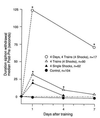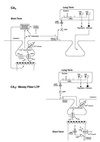Toward a molecular definition of long-term memory storage
- PMID: 8942955
- PMCID: PMC33629
- DOI: 10.1073/pnas.93.24.13445
Toward a molecular definition of long-term memory storage
Abstract
The storage of long-term memory is associated with a cellular program of gene expression, altered protein synthesis, and the growth of new synaptic connections. Recent studies of a variety of memory processes, ranging in complexity from those produced by simple forms of implicit learning in invertebrates to those produced by more complex forms of explicit learning in mammals, suggest that part of the molecular switch required for consolidation of long-term memory is the activation of a cAMP-inducible cascade of genes and the recruitment of cAMP response element binding protein-related transcription factors. This conservation of steps in the mechanisms for learning-related synaptic plasticity suggests the possibility of a molecular biology of cognition.
Figures






References
-
- Polster M R, Nadel L, Schachter D L. J Cognit Neurosci. 1991;3:95–116. - PubMed
-
- Squire L R. Psychol Rev. 1992;99:195–231. - PubMed
-
- Hawkins R D, Castellucci V F, Kandel E R. J Neurophysiol. 1981;45:315–326. - PubMed
-
- Pinsker H M, Hening W A, Carew T J, Kandel E R. Science. 1973;182:1039–1042. - PubMed
Publication types
MeSH terms
Substances
Grants and funding
LinkOut - more resources
Full Text Sources
Other Literature Sources
Medical
Molecular Biology Databases

